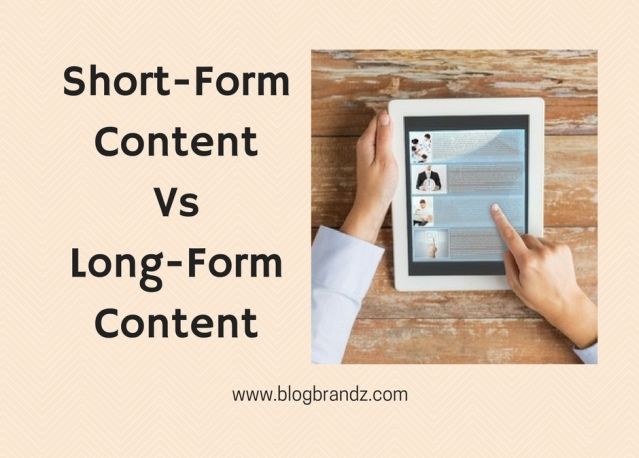What are the pros and cons of long-form content vs short-form content and which one should you publish on your blog?
With the growing popularity of connected mobile devices, including smartphones and tablets, people around the world are consuming a huge amount of content. If you include conventional desktops and laptops, the number goes up even more.
However, marketers face the dilemma of choosing short-form content over long-form content for their content strategy. Truly, the right way to approach this confusion lies in adopting an appropriate mix of long-form and short-form content as both have their advantages.
Contents
The Advantages Of Short-Form Content
With the glut of online content and the reduced attention span of readers, many organizations are opting for short-form content for their content marketing needs. Most of this short-form content is in the form of blogs and infographics that are less than 1000 words in length.
Readers online are impatient and want their queries to be answered as quickly as possible, so many of them avoid going through each and every word of an article and normally prefer to read shorter blogs.
Short-form content helps a business connect and engage with its audience. It also has the advantage of brief verbiage that allows a brand to deliver a strong message quickly and effectively to its audience.
Short-form content can also be easily read on mobile devices, as a result helping it reach out to a large number of viewers. Here are some of the merits of short-form content over long-form:
#1. Short-form content works best for scanners
The majority of the readers online are scanners – those who scan through an article quickly rather than going through it in detail. Such readers prefer short-form content rather than long-form.
#2. Short-form content is mobile-friendly
In the age of mobile technology where more than half of online readers have access to content on their mobile devices, short-form content has a clear advantage over long-form content.
People are likely to avoid reading long-form content that they need to scroll to read on a mobile device.
#3. Takes less time to create and can be generated in bulk
Another key advantage of short-form content is the fact that it can be created in a short time and can be generated in bulk.
Organizations normally take the help of short-form content to write about news or topics that are trending in their industry, and it doesn’t compete with the branding that the long-form content achieves for them.
#4. Builds the habit of creating more content
Individuals who maintain their own personal blogs prefer short-form content as it helps them build the habit of writing more. Short-form content can also be easily shared on various platforms such as LinkedIn, Twitter, and Facebook.
The Advantages of Long-Form Content
Many enterprises opt for long-form content published in the form of case studies, white papers, webinars, or e-books. Long-form content generally contains more than 2000 words and is intended to inform and educate.
Businesses prefer to use long-form content, as search engines rank them higher than short-form content for the same keywords used, and as such, they have greater visibility.
It has also been proven that the longer the content, the more it gets shared. Long-form content is more likely to go viral. Here are some of the merits of long-form content over short-form:
#1. Ideal for attracting quality backlinks
One of the biggest SEO benefits of using long-form content is backlinks. With long-form content, it is easier to generate organic traffic and improve your ranking on search engines.
As companies across different verticals try harder to find influential content in their industry to include in their content, publishing long-form content goes a long way in becoming influential.
#2. Gives the reader a deeper understanding of the topic
A definitive piece of content on any topic gives readers a deeper understanding of the topic and establishes the organization or individual as a thought leader in the industry by showcasing your knowledge on a specific subject.
Long-form articles will continue to be considered the definitive source for readers well into the future, as a result becoming evergreen content.
#3. Lower costs for inbound marketing
Companies across the world can save more money, in the long run, by using long-form content by optimizing their inbound marketing efforts.
Long-form content differentiates a company from its competition and continues to generate leads for a longer period of time, as a result making the best use of the returns on the investment.
#4. Caters to an audience that is deeply invested
Long-form content is targeted at readers who are deeply invested in a particular industry or topic. They are likely to go through the entire article and give positive reviews and comments.
There is also a good chance that they will check out your future posts as well and become loyal subscribers to your mailing list.
#5. Has a longer lifespan
Unlike short-form content, long-form content has a much longer life span, as a result making it worthwhile for a writer who invests their valuable time and effort in creating such content.
#6. Enjoys greater credibility
In an online market that has crossed saturation point, the only way to make a significant impact on customers is to prove that a brand is a reliable source of pertinent information.
Organizations can use long-form content as a tool to enhance their credibility and earn the respect of consumers. This also results in greater returns from marketing campaigns.
There are a lot of factors involved in carrying out a successful content marketing campaign and both short-form content and long-form content is needed to make it effective.
Organizations must find the right mix as both types of content have their own value and purpose.
Optimal Length Of Blog Posts & Social Media Content
Have you ever asked yourself, “How long should my blog post be?” Well, this handy infographic from the guys at BufferSocial has all the answers.
From the optimal length of blog posts to the length of your LinkedIn, Facebook, Twitter, and YouTube content, you’ll find this information invaluable as you start creating a social media calendar for your business.
Tip: With blog posts nowadays, longer is better. According to the infographic below, 1600 is the optimal post length (Whew!). That’s going to keep us content marketers busy as hell!
More writing tips and tutorials
- 16 types of writing skills and how to learn them
- 21 SEO tips for blogs: Bloggers SEO for beginners checklist
- SEO content writing tutorial to write SEO-optimized content
- Social media content ideas for engaging social media posts
- How to start your own web content writing business
- Best SEO content writing tools to write SEO-friendly articles
- 12 fast writing tips: Learn how to write fast & write well
- Best AI writing generator tools for writing AI content
© 2016 – 2022, Priya Florence Shah. All rights reserved.
Priya Florence Shah is a bestselling author and an award-winning blogger. Check out her book on emotional self-care for women. Priya writes short stories and poetry and chills with her two-legged and four-legged kids in her spare time.
Discover more from Business & Branding Tips
Subscribe to get the latest posts sent to your email.





I’m glad you wrote about this, Priya, It seems that every time I meet with someone for some advice about content, they recommend the opposite of what I’m writing. That is, if I’m trying to keep it short, they tell me to make it long, and if I’m trying to make it long they tell me to keep it short. And these are the experts. Now I know why the difference of opinion. They’re aiming for different goals. That explains it. I mean, I know they’re not ignorant. Thanks for showing me where I was ignorant. I feel better now. 🙂
Glad you found it useful, Michael. It’s totally about meeting different goals and catering to different audiences. Short-form is suitable for some forms of media, while long-form works better on others. Plus it’s about what goals your content is aimed at achieving. Ultimately, the kind of mix you adopt depends on your unique business needs and KPIs.